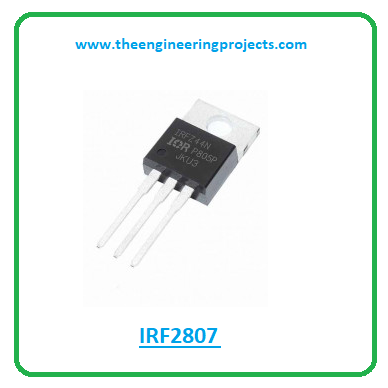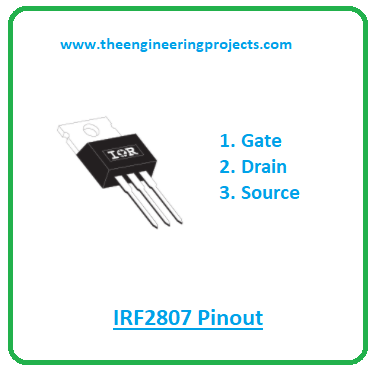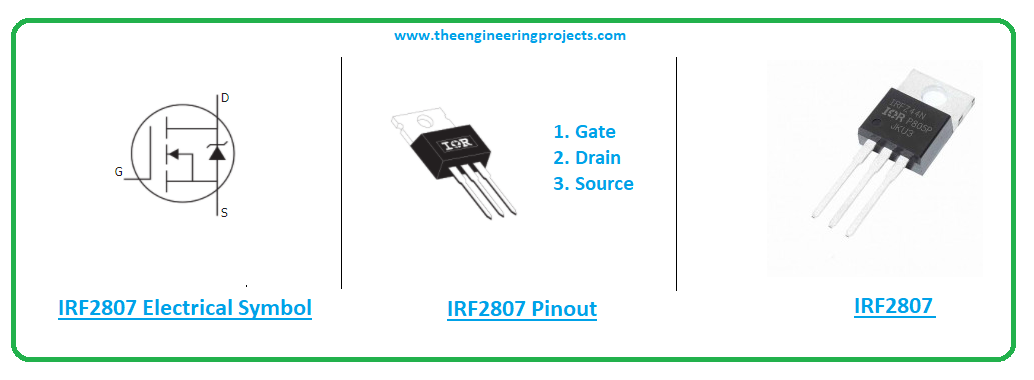
Hello Folks! Hope you’re well today. Happy to see you around. In this post today, I’ll walk you through the Introduction to IRF2807. The IRF2807 is an N-channel MOSFET made up using advanced process technology to obtain extremely low on-resistance. This device is fully avalanche and is mainly used in fast switching applications. It comes in TO-package which is universally accepted for commercial-industrial applications. I suggest you buckle up as I’ll detail the complete Introduction to IRF2807 covering datasheet, pinout, features, and applications. Let’s dive in.
Introduction to IRF2807
- The IRF2807 is an N-channel MOSFET that comes with a power dissipation of around 200W.
- This device is mainly used for fast switching applications and low thermal resistance and low package cost makes this advice an ideal pick for a range of industrial applications.
- The IRF2807 contains three terminals called the gate, drain, and source. At times, this is considered as a four-terminal device when the body is taken as the fourth terminal of the device.

- The electrons enter the channel through the source terminal while they leave the channel through the drain terminal. The gate terminal plays an important role in the biasing of the device and it stands between the source and drain terminals. The voltage on the gate terminal controls the channel width.
- This IRF3710 MOSFET comes with extremely low ON resistance, making this device preferable for low drop switching applications. The low drop is responsible for low power loss, thus guarantees greater efficiency.
- The MOSFETs are termed the voltage-controlled device in opposed to bipolar junction transistors that are current-controlled devices and contain terminals emitter, base, and collector.

- The MOSFET works in two modes i.e. depletion mode and enhancement mode.
- And the behavior of electrons is different in both these modes. During the enhancement when there is no voltage across the gate terminal, there will be no current across the channel. While when voltage is applied across the gate terminal, the conductance of the device will increase.
- During depletion mode, however, when no voltage is applied across the gate terminal, there is conductance across the channel. While, when the voltage is applied, the channel conductivity will decrease.
- The MOSFETs are mainly divided into two main types i.e. P-channel MOSFET and N-channel MOSFET. The IRF2807 belongs to the N-channel MOSFET where conductance is carried out by the movement of electrons.
- In P-channel MOSFETs conductance is carried out by the movement of holes. The movement of electrons is better than the movement of holes, making N-channel MOSFET better than P-channel MOSFETs for a range of applications.
IRF2807 Datasheet
Before you embed this device into your electrical project, it’s wise to go through the datasheet of the component that features the main characteristics of the device. You can download the datasheet of IRF2807 by clicking the link below.IRF2807 Pinout
The following figure represents the pinout diagram of IRF2807.
| Pin Description of IRF2807 | ||||
|---|---|---|---|---|
| Pin No. | Pin Description | Pin Name | ||
| 1 | Used for biasing the device | Gate | ||
| 2 | Electrons leave the channel through this terminal | Drain | ||
| 3 | Electrons enter the channel through this terminal | Source | ||
IRF2807 Features
The following are the main features of IRF2807.- Type = N-Channel MOSFET
- Department = Transistors
- Category = IRF series
- Power Dissipation (Ptot) = 200W
- Fully avalanche rated
- Drain-Source Volt (Vds) = 100V
- Advanced process technology
- Gate-Source Volt (Vgs) = 20V
- Ultra-low on-resistance
- Dynamic dv/dt rating
- Drain Current (Id): 58A
- Package = TO-220
IRF2807 Applications
The IRF2807 is used in the following applications.- Used in USP
- Employed in instrumentation projects
- Used in embedded projects
- Employed in Inverters
- Incorporated in switching applications




